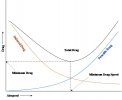I've tried searching for the empirical evidence of it and don't find any links
If you want "empirical evidence" on just how long you can fly your drone after you've pushed it beyond a reasonable distance and you still hope to get it home then you need to perform the test yourself. You need to do this yourself because the data is based your drone's flight characteristics and your flying methods.
Take two batteries that are as closely matched as possible, number of charges, and voltage when fully charged, then go find a large flying area, bring a lawn chair, and fly your drone around. I would suggest set the drone to Normal Speed and give it full forward and just a touch of Left or Right Roll (by holding the stick at One or Eleven O'clock position, the Drone will just fly large lazy circles (hence the lawn chair…).
As the batteries run down to the 20% level, keep your drone close. As soon as your drone screams, "Bring me home, I don't want to die…" land it and shut the motors down. By restarting the motors, this will establish a new flight, and your app will now keep track of the distance and the flying time separate from the previous flight…
Now, this is all on you, because it is recommended not to run your batteries down to 0%, but you want that "empirical evidence"… Therefore, take you drone back up and continue to fly, still at Normal Speed, and fly it until it goes into a force landing…
Now, go get your drone if you were not able to bring it home and give it a kiss, because it deserves it… Let your drone cool off, have a cool one yourself because you are going to do this all over again…
With a fresh battery, fly the above mentioned pattern again, still at normal speed. And again when the Drone battery is at 20%, and your Drone is again crying, "Please, not again…" Land It and shut the motors down. Once again, this will establish a separate Flight.
Now this time when you take off with the battery at 20%, set your Drone on Sport Mode and fly those same flight patterns but you will be going a lot faster and therefore should deplete the battery much faster and again fly it until it goes into a force landing…
I fly with a WiFi tablet with no internet and I've never tried to bring up the Flight Data Center while in the field. You can try, I do it from home with my tablet connected to the internet.
To get your "empirical evidence," open the DJI Fly App, On the Intro Screen, Tap the Profile Icon (lower left center), Tap MORE (Bottom Left), and that bring use the Flight Data Center. Assuming you did not fly any more since performing your flight tests, the Top Entry will show you the distance and flight time of that last flight on 20% battery, flying in Sport Mode.
The Second entry was the flight running down the battery…
The Third entry is "empirical evidence" for the distance and flight time of that flight on 20% battery, flying in Normal Mode.
So, based on the flying time and flying distance of these two flight; you should be able to determine if flying slower (Normal Mode) for a longer time verses flying faster (Sport Mode) but for a shorter time, give you a greater chance of getting home on a depleted battery.
If you Tap on the actual entry, it will bring up the actual flight telemetry map, the flight pattern, and plays it like a video of your flight. You can even bring up the satellite map and see the actual stick movements as you flew…
As a point of interest, the distance, and the flight time for the second and the forth flights should be very similar… Remember, you were just lazily flying your drone around running the battery down to the 20% level.
Finally, I am sure there are more scientific methods of establishing this empirical evidence, but there is nothing like having the real Proof in the Pudding verses, hypnotically, "The battery should have blah, blah, blah…"











